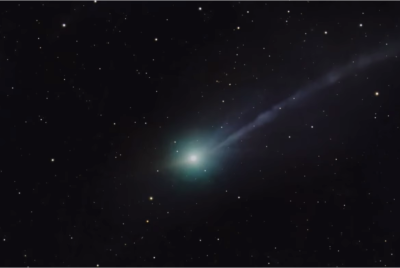3I/ATLAS Shock: Avi Loeb Says NASA's Images of Interstellar Object Are 'Nothing More Deceptive'
As 3I/ATLAS races away from the Sun at more than 200,000 km/h, its final close-up opportunities vanish after mid-December 2025

Harvard astrophysicist Avi Loeb's scathing critique of NASA's 3I/ATLAS images has ignited a full-blown cosmic storm, accusing the agency of 'deceptive' releases while new anomalies fuel speculation about alien tech. With the interstellar visitor hurtling towards its 19 December 2025 Earth flyby, the controversy has become as compelling as the comet-like object itself.
Discovered on 1 July 2025 by Chile's ATLAS telescope, 3I/ATLAS's hyperbolic path continues to defy natural odds, prompting fierce debate over whether it is a rogue comet or an engineered probe.
Loeb's Fiery Rebuke: NASA's 'Fuzzy' Images Fall Short
Avi Loeb, Harvard's Galileo Project head, lambasted NASA's 19 November 2025 image drop as underwhelming, quoting Sherlock Holmes: 'There is nothing more deceptive than an obvious fact.' The High Resolution Imaging Science Experiment (HiRISE) aboard Mars Reconnaissance Orbiter captured 3I/ATLAS on 2 October 2025, at 0.2 astronomical units (19 million miles) away, rendering it a mere 'fuzzy ball of light' at 30 km/pixel resolution.
Loeb, in his Medium blog, decried the lack of emphasis on amateur astronomers' 'far more exciting' shots revealing million-kilometre collimated jets. NewsNation reports Loeb pressed NASA amid a 42-day US government shutdown delaying data, arguing the images merely show surface 'ices and dust'—potentially masking a technological core accumulated over interstellar travel.
X user @Tusharufo2 echoed: 'NASA is being deceptive... jets seen by amateur astronomers... did not receive emphasis.' This standoff highlights tensions between institutional caution and bold inquiry.
So Avi Loeb is saying that NASA is being deceptive in it’s handling of the 3I/Atlas. He gives several reasons for this.
— Tushar (@Tusharufo2) November 20, 2025
1. Lack of novelty in the presentation
The image shown by NASA (from the Mars Reconnaissance Orbiter’s HiRISE camera) is very low‐resolution (30 km/pixel),… https://t.co/z5wZuwT4xa
Anomalies Ignited: Why 3I/ATLAS Defies Comet Norms
Loeb lists 12 anomalies rendering 3I/ATLAS' natural origin improbable, starting with its mass—a million times 'Oumuamua's and a thousand times 2I/Borisov's—implying we'd spot a million similar objects before this rarity unless 'intentionally targeting' our system.
Discovered 1 July 2025 at 4.5 AU from the Sun, its retrograde trajectory aligns within 5 degrees of the ecliptic plane—a 0.2% likelihood fluke Loeb pegs at 100,000 times improbable for random interstellar ejections.
Economic Times coverage amplifies Loeb's call for transparency, noting powerful jets akin to 'rocket thrusters' in amateur images from 11 November 2025 by The Virtual Telescope Project.
Critics like Penn State's Jason Wright counter these as overstated, but Loeb's 30-40% artificiality odds persist, urging data over dogma. X post from @Truthpolex highlights: 'New Images Show 3I/ATLAS Does Not Have a Tail - Avi Loeb... Suggests it is Bluer and Brighter.' These quirks demand deeper scrutiny.
🚨 BREAKING - New Images Show 3I/ATLAS Does Not Have a Tail - Avi Loeb on NBC News Also Suggests it is Bluer and Brighter#Ufotwitter #3IATLAS pic.twitter.com/S3mH4ktknj
— T R U T H P O L E (@Truthpolex) November 6, 2025
Backlash and Broader Ripples: Science vs Spectacle
Loeb's claims have drawn fire for sensationalism, with Reddit's r/space thread condemning his 40% spacecraft hedge as 'bad-faith "just asking questions"' rhetoric, reportedly fuelling conspiracies such as 'NASA IS LYING!'
Every Single One Of Loeb’s 3I/ATLAS “Anomalies” Deconstructed | Avi Loeb carefully hedges the probability it's a spacecraft around 40%, giving him plausible deniability of the bad-faith “just asking questions” variety while still making the comet sound weird enough to get him TV time and fan mail.
by u/ChiefLeef22 in space
NASA, affirms no technosignatures post-8 September 2025 Psyche trailing, quashing probe mania amplified by shutdown silence. NorthJersey clarifies confusion with C/2025 K1 (ATLAS)'s fragmentation, unrelated to 3I/ATLAS' intact state.
Loeb retorts in NewsNation: 'What they uncovered was the 'skin' of the object ... some ices and perhaps some dust that evaporates when the sun illuminates that surface,' he further added 'Even if you consider spacecraft that travels through the core of the interstellar medium, it would accumulate over time — ices and dust on it.'
X's @disclosureorg warns: 'NASA... will not release them to the public for unknown reasons.'
Harvard astrophysicist Avi Loeb says that the interstellar object 3I/ATLAS is behaving very strangely. NASA reportedly captured detailed images of the 3I/ATLAS object but will not release them to the public for unknown reasons. pic.twitter.com/Z9NHEPs9HQ
— Disclosure Party (@disclosureorg) November 4, 2025
As 3I/ATLAS races away from the Sun at more than 200,000 km/h, its final close-up opportunities vanish after mid-December 2025. Hubble's last scheduled observations end on 15 December, and the James Webb Space Telescope has already shifted to other targets. Whatever secrets the object still carries (natural iceberg or engineered relic) will soon be locked beyond the reach of current instruments.
© Copyright IBTimes 2025. All rights reserved.





















